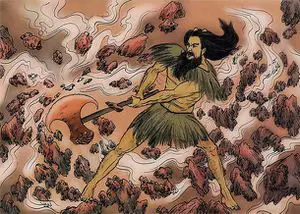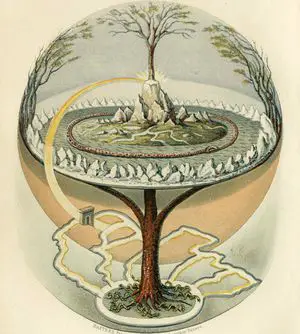What is the history of creation mythologies
Creation myths are common in many cultures in the New and Old Worlds. Creation myths often form parts of religions but they are also stories or traditions passed on among different cultures. Creation myths also shape the worldview of different cultures and we see that they often are important in how societies understand their place in the wider world.
Contents
Some Types of Creation Myths
Creation myths can be found in many regions and, in fact, are probably the most common form of myth. Creation myths were likely evident in very early cultures around the world as they would have been likely told as oral stories that would be passed from one generation to another. Because creation myths are oral stories, these stories probably have changed numerous times and many different versions often exist for any one culture. Among early literate societies in the Middle East, creation myths appear early in ancient texts. The Sumerian myth focuses looks at how the gods An (sky), Enlil (supreme god), Enki (water) and Ninhursanga (mother goddess) gods created the world. Humans were created from clay but were almost destroyed by a great flood after the gods complained of their noise, where the hero Atrahasis survived along with his family and creatures of the Earth. One of the best known is Enûma Eliš, which is a myth that describes humans as made to serve the gods as gods wanted to be relieved from their work. The creation story does not put humans at the center but rather the main story is the triumph of the god Marduk is his struggle with Tiamat. After this struggle, the world order fell in place, with Marduk as supreme god and the hierarchy of power in the cosmos was established, with Marduk as head. This myth is similar to others that also tell of the cosmos as being born our of chaos. In ancient Chinese cultures, Pangu was seen as a creation being that created the world out of a chaotic form (Figure 2). Initially, everything was in an egg-shaped universe that became separated by Pangu and he created the earth, separating the balance of the cosmos and life, Ying and Yang. Creation from chaos is perhaps the most common form of creation. Another example is from Siberia, where Buga set fire to an ocean that created land and see and he also create light and darkness by separating the two. The god fought Buninka, an evil god, to create mankind. Similar to other traditions, man was made from earth, while other elements, such as fire, iron, and water made up the rest of the world. In ancient Greek mythology, the universe was chaotic and Gaia, representing the Earth, emerges out of this. Uranus is born from Gaia, who then impregnates her and she gives birth to the Titans. Prometheus, one of the Titans, creates humans, and similar to other Mediterranean-based mythologies, uses dirt or clay to make humans. In Central Africa, Mbombo, a god, existed in a universe of nothing but primordial ocean. Eventually, he vomits out the cosmos and the Earth emerges from the primordial sea. Mbombo also vomited to create nine animals that would then bring the other animals of the Earth.[1]
While many creation myths in the Old World that deal with the creation of the world and even humans often use chaos as part of the story, in the New World creation is often based on birth from a mythical being. The goddess Coatlicue is a goddess who gave birth to Huitzilopochtli, who himself was a god of war and killed conspiring gods, including one to create the moon by throwing the gods head into the sky. In Hawaiian mythology, Kumulipo represents creation of the universe where each cosmic night a different being or entity is born. Humans and other creatures are born over a given night. Some Old World mythologies also emphasize births as part of creation. In the Heliopolis creation myth from Egypt, Shu and Tefnut give birth to the earth and sky gods that then give rise to Osiris, Isis, Set, and Nephthys, which create the foundations for life. Atum, however, is the initial god that enabled the multiplicity of elements that made life possible and even other gods. Similarly, in the Memphis tradition, the creation story focused on Ptah and how his skills in fashioning objects enabled him to create life and everything including the gods. This tradition co-existed with the Heliopolis tradition and could have been blended with it as well. In Cherokee and some Native American mythology, the Earth was seen as a great floating island where life spread. The first humans created were broth and sister and,initially, they had children every seven days. But this led the world to be overpopulated, so birth was restricted to one per year. The Earth island attracted all sorts of life as the soil became dry and life began to fly down or go down to enjoy living on the island.[2]
Key Themes
For the creation myths that relate to chaos, or the world emerging from chaos, the oceans are often seen as the initially created entity that a god or spirit then allows the Earth or even the heavens to emerge from this primordial sea. Chaos, war, and conflict are also common in the Old World. Both in Mesopotamian and Egyptian mythology, nothing exists and creation brings order to a world of nothingness.In the New World, birth is a common theme, where the spirits or gods beget other gods. Sometimes the gods are impregnated in a divine miracle. Themes of war also appear, such as in the Hopi creation epic, which recounts the wickedness and promiscuity of humans that leads to conflict and downfall. Emergence out of a pre-human world, including the emergence of key elements that allow life to happen, are also common in the New and Old Worlds. The Tree of Life is perhaps one of the most important symbols in the Old World in relation to creation. It is symbolic in connecting heaven and the underworld and living things are connected through this tree (Figure 2). In the Navajo tradition, spiritual aspects were created first before the world and other beings were created. The spiritual characteristics of life enable the physical world, including humans, to exist. Both in east Asia and the New World, the Earth emerges as dry land created by a divine being or being sent by the gods. For instance, the Ainu creation myth has a water wagtail bird create the Earth by flapping its wings and exposing dry land.[3]
Influence of Creation Myths
In most cultures, it is evident that creation myths are also developed to justify the world order. The hierarchy of humans, the reasons why they might die, the importance of given gods but not others, and the characteristic of the spirits and gods are justified by creation myths. This is also true for major religions, where creation stories are used to explain what the world was intended to be and how it is. Creation myths are, therefore, central in many belief systems that explain the cosmos and are the most typical stories of cosmology in ancient cultures. Prior to creation, the universe or the world is considered unclear and order is often not well established. Creation myths are, therefore, seen as important for social truths, including metaphorical and symbolic meaning. While many creation myths are often not believed in even by modern cultures, they are still seen as important for social identity given their explanatory utility in justifying world order and the place of given cultures. For disappearing or more rare cultures, including Native American societies, creation myths are important for identity and placing society in a wider world view.[4]
Summary
There is no shortage of creation myths and certainly there are many more that we know little about. Many have common themes of birth, chaos, war, and the establishment of social hierarchy. What these show is that the foundations of life today are explained by these creation myths, even if they are often unclear as to their timeline and see to have occurred in a time that one would find unfamiliar. Common themes tell us that many stories were likely shared among cultures as they migrated and interacted, where traditions and stories often evolved to reflect changes in society.
References
- ↑ For more on a summary of key or major creation myths, see: North, C., Robinson, A., 2009. In the beginning: creation myths from around the world , Artwork by Adrienne Robinson. ed. ICRL Press, Princeton, New Jersey.
- ↑ Although old, first hand accounts often allowed many New World myths to be recorded, see: Brinton, D. 2002. The Myths of the New World . CreateSpace.
- ↑ For more on common themes among different creation epics and myths, see: Leeming, D.A., Leeming, M.A., 1995. A dictionary of creation myths. Oxford University Press, New York.
- ↑ For more on how creation myths influenced modern society, see: Franz, M.-L. von, Franz, M.-L. von, 1995. Creation myths. Shambhala, Boston.

